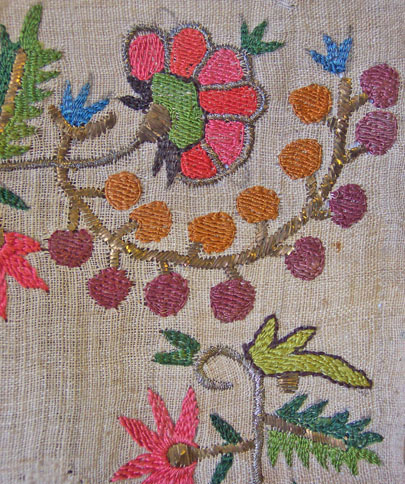embroidery & towel
Summary
Loosely woven towel in unbleached linen. Centre panel with triangles darned in white floss silk. 7.6cm border with sprigs of stylised flowers in silver (with a core of pale yellow silk) and gold strips and coloured silks (red, bright pink, shades of green, purple, turquoise and pale brown). Rolled hem.
Display Label
Embroideries from Islamic countries are often characterised by their arabesque designs, although specifically religious motifs also feature. The appearance of the animal and especially the human form is uncommon, and the emphasis is often on the talismanic properties of a pattern or motif. These geometric patterns appear as borders, often repeating a stylised plant form, trees and birds. Birds are believed to bring good fortune and the tree often represents the 'Tree of Life'. The 'Hand of Fatima' and the eight pointed star are also a popular symbolic motif in this type of embroidery. Fez embroidery, otherwise known as 'terz d-el ghorza' is a popular type of Moroccan embroidery, with a distinctive diamond pattern, which can also be found in the carving of doors and architectural features of large houses in Morocco. The embroiderer works without a pattern, counting the threads of the cotton cloth to which embroidery is applied, and using one colour silk threads which are doubled or tripled. Usual stitches are fez stitch, stem stitch and other modified stitches. Moroccan embroidery is characterised by geographical areas. The patterns found in the embroideries of Azemmour are formed though the ground area being left blank. In the example shown peacocks are bordered by vases, which is a popular Christian or Classical motif. Algerian 'red and blue' and 'purple' work is named after the dense embroidered patterns of the often naturally dyed embroidery threads. Dating from the seventeenth century this embroidery is applied using a slanted brick stich or 'ma'alka' and satin stitch. A popular motif in Algerian embroidery is the artichoke or pomegranate shape, a shape which can be found in embroideries across Asia. Turkish embroidery is very delicate and found on small domestic items. Pink and green floral motifs featuring goldwork is worked on a beige crinkly cotton. Outlining is popular and appears on groups of flower heads with a serrated curved leaf or hyacinth stem. Other characteristic motifs are red and blue artichokes and tulips surrounded by smaller unworked floral patterns. The embroidery of Perisa draws heavily on the design of the garden and vases, bouquets of flowers and trees of birds can be found in the embroidery of Resht. Detailed embroidery from women's trousers legs is worked in cross stitch and petit point in diagonal lines.
Object Name
embroidery & towel
Date Created
1850-1900
Dimensions
(Length : 36 in):
(Width : 16 in): 40.6cm
accession number
1929.174
Collection Group
Place of creation
Turkey
Medium
Credit
Bequeathed by Mrs Ruth Emma Day, 1929
Legal
© Manchester Art Gallery


